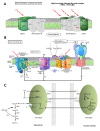Photosynthetic Regulation Under Salt Stress and Salt-Tolerance Mechanism of Sweet Sorghum
- PMID: 32010174
- PMCID: PMC6974683
- DOI: 10.3389/fpls.2019.01722
Photosynthetic Regulation Under Salt Stress and Salt-Tolerance Mechanism of Sweet Sorghum
Abstract
Sweet sorghum is a C4 crop with the characteristic of fast-growth and high-yields. It is a good source for food, feed, fiber, and fuel. On saline land, sweet sorghum can not only survive, but increase its sugar content. Therefore, it is regarded as a potential source for identifying salt-related genes. Here, we review the physiological and biochemical responses of sweet sorghum to salt stress, such as photosynthesis, sucrose synthesis, hormonal regulation, and ion homeostasis, as well as their potential salt-resistance mechanisms. The major advantages of salt-tolerant sweet sorghum include: 1) improving the Na+ exclusion ability to maintain ion homeostasis in roots under salt-stress conditions, which ensures a relatively low Na+ concentration in shoots; 2) maintaining a high sugar content in shoots under salt-stress conditions, by protecting the structures of photosystems, enhancing photosynthetic performance and sucrose synthetase activity, as well as inhibiting sucrose degradation. To study the regulatory mechanism of such genes will provide opportunities for increasing the salt tolerance of sweet sorghum by breeding and genetic engineering.
Keywords: Na+ exclusion; photosynthesis; salt-tolerance mechanism; sugar content; sweet sorghum.
Copyright © 2020 Yang, Li, Liu, Xie and Sui.
Figures


References
-
- Ahmad P., Prasad M. (2012). Environmental adaptations and stress tolerance of plants in the era of climate change (New York: Springer Science & Business Media; ). 10.1007/978-1-4614-0815-4_2 - DOI
-
- Almodares A., Hadi M. R. (2009). Production of bioethanol from sweet sorghum: a review. Afr. J. Agric. Res. 4, 772–780. 10.1021/jf9024163 - DOI
-
- Almodares A., Hadi M. R., Dosti B. (2007). Effects of salt stress on germination percentage and seedling growth in sweet sorghum cultivars. J. Biol. Sci. 7, 1492–1495. 10.3923/jbs.2007.1492.1495 - DOI
Publication types
LinkOut - more resources
Full Text Sources
Miscellaneous

